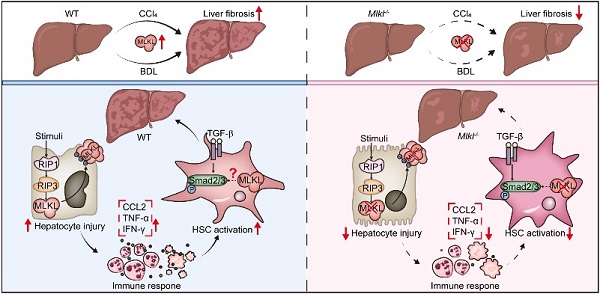Scientists Discover MLKL as a Potential Therapeutic Target for Liver Fibrosis
Liver fibrosis affects millions of people worldwide without an effective treatment. In a recent study published in Theranostics, a group of scientists led by Xie Xin from the Shanghai Institute of Materia Medica (SIMM), Chinese Academy of Sciences, collaborating with DING Zhenbin from Zhongshan Hospital, Fudan University, and GAO Zhaobing from SIMM, reported the critical function of MLKL (mixed lineage kinase domain-like protein) in liver fibrosis, and suggested that AAV-mediated knockdown of MLKL might provide effective therapy (1). The journal also published an editorial to comment on this important discovery and discuss future research and application (2).

Liver fibrosis is a multicellular response to liver injury. Although multiple cell types in the liver contribute to the fibrogenic process, hepatocyte death is considered to be the trigger. It is generally believed that hepatocyte damage causes inflammatory responses, and then the pro-inflammatory cells produce cytokines to activate and transdifferentiate quiescent hepatic stellate cells into myofibroblasts, leading to extracellular matrix deposit and progressive liver fibrosis. Multiple forms of cell death, including necrosis, apoptosis, and necroptosis, have been reported to co-exist in liver diseases. Mixed lineage kinase domain-like protein (MLKL) is the terminal effector in necroptosis pathway. Although necroptosis has been reported to play an important role in a number of liver diseases, the function of MLKL in liver fibrosis has yet to be unraveled.
In this research the scientists discovered that MLKL level was positively correlated with a number of fibrotic markers in liver samples from both patients with liver fibrosis and animal models. Mlkl deletion in mice significantly reduced clinical symptoms of CCl4- and bile duct ligation (BDL) -induced liver injury and fibrosis.
Further studies indicated that Mlkl-/- blocked liver fibrosis by reducing hepatocyte necroptosis and hepatic stellate cell (HSC) activation. AAV8-mediated specific knockdown of Mlkl in hepatocytes remarkably alleviated CCl4-induced liver fibrosis in both preventative and therapeutic ways.
These results showed that MLKL-mediated signaling played an important role in liver damage and fibrosis, and targeting MLKL might be an effective way to treat liver fibrosis.

References:
1.Ren Guo, Xiaohui Jia, Zhenbin Ding, Gang Wang, Mengmeng Jiang, Bing Li, Shanshan Chen, Bingqing Xia, Qing Zhang, Jian Liu, Ruting Zheng, Zhaobing Gao, Xin Xie. Loss of MLKL ameliorates liver fibrosis by inhibiting hepatocyte necroptosis and hepatic stellate cell activation. Theranostics 2022; 12(11), 5220-5236.
2.Valeria Pistorio, Chantal Housset, Jérémie Gautheron. Multiple functions of MLKL in liver fibrosis, from necroptosis to hepatic stellate cell activation. Theranostics 2022; 12(13):5820-5823
Link:
CONTACT:
DIAO Wentong
Shanghai Institute of Materia Medica
E-mail: diaowentong@simm.ac.cn




